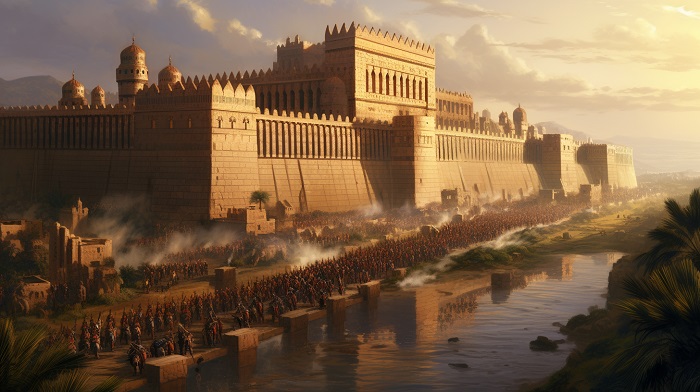
Enveloped in the sands of time, the historical context of encryption in Babylon unveils a captivating narrative, intertwining the intricacies of ancient communication, the imperative for secrecy, and the evolution of cryptographic practices. As we embark on this exploration, we delve into the very fabric of Babylonian society, where the exchange of messages was not merely a transaction of words but a manifestation of power, governance, and military strategy.
Communication in ancient Babylon was a dynamic tapestry woven with the threads of necessity. As the city-state burgeoned into a hub of civilization, messages became vessels of power in administrative and military realms alike. The need for secrecy emerged organically, a response to the delicate nature of diplomatic missives, military strategies, and matters of governance. This section unravels the layers of Babylonian communication, exposing the roots of secrecy embedded in its very essence.
Within the clay tablets that encapsulate Babylon’s history, whispers of encryption methods echo softly. While concrete evidence remains elusive, the societal intricacies suggest a dance with cryptographic techniques. Symbolisms, codes, or ciphers might have been the silent guardians of sensitive information, shielded from prying eyes. The hierarchical structure of Babylonian governance and the looming importance of military intelligence form the canvas upon which we paint a speculative tableau of ancient Babylonian encryption.
Secrecy, an unspoken currency in Babylon, wove its tendrils through the corridors of power. Kings, rulers, and military strategists were custodians of classified plans, guarded fiercely by encryption’s embrace. In the governance of a thriving city-state and the orchestration of military campaigns, confidentiality was the linchpin. This section unravels the symbiotic relationship between secrecy and the heartbeat of Babylon, examining how encryption played a pivotal role in steering the course of governance and military affairs.
As we navigate the labyrinth of Babylonian encryption, this journey is both a testament to the enduring quest for secure communication and a celebration of the ancient ingenuity that birthed cryptographic practices. Join us in this exploration, where each encrypted symbol etched into clay tablets becomes a portal, offering glimpses into a civilization’s secrets, power dynamics, and the artistry of securing the sacred exchange of words.
Table of Contents
Historical Context of Encryption in Babylon

In exploring the historical context of encryption in Babylon, it’s crucial to consider the early forms of communication and the necessity for secrecy that arose in various aspects of Babylonian society, including governance and military affairs.
A. Early Forms of Communication and the Need for Secrecy:
Communication in ancient Babylon relied on various methods, primarily driven by the need to convey information efficiently and securely. As Babylon developed into a flourishing civilization, the exchange of messages became pivotal in both administrative and military spheres. The need for secrecy in certain communications emerged due to the sensitive nature of diplomatic correspondence, military strategies, and governance matters.
B. Exploration of Ancient Babylonian Methods of Encryption:
While concrete evidence of encryption methods in ancient Babylon is scarce, the complexity of their society suggests a potential use of cryptographic techniques. Babylonians might have employed symbolisms, codes, or ciphers to safeguard sensitive information from unauthorized access. The hierarchical structure of Babylonian governance and the importance of military intelligence could have motivated the development of rudimentary encryption practices.
C. Role of Secrecy in Babylonian Governance and Military Affairs:
Secrecy played a pivotal role in Babylonian governance and military affairs. Kings, rulers, and military commanders needed to ensure the confidentiality of their plans, strategies, and decisions. Encryption, whether through linguistic codes or other methods, would have been instrumental in maintaining the security of critical information. The success of military campaigns and the effectiveness of administrative rule often hinged on the ability to keep certain details confidential.
In conclusion, the historical context of encryption in Babylon is rooted in the need for secure communication in both governance and military realms. While specific encryption methods used by the Babylonians remain speculative, the importance of secrecy in their society underscores the likelihood of employing some form of encryption to protect vital information. The intersection of communication, secrecy, and encryption reflects the sophisticated nature of ancient Babylonian civilization.
Babylonian Ciphers and Cryptography

In ancient Babylon, the utilization of basic cryptographic concepts was likely driven by the need for secure communication. Cryptography, in its early forms, aimed at encoding messages to prevent unauthorized access. The Babylonians might have employed rudimentary cryptographic principles involving symbols, codes, or other linguistic methods to ensure the confidentiality of critical information.
While concrete evidence of specific Babylonian encryption methods is limited, indirect references in historical texts suggest the existence of encryption practices. Babylonian ciphers might have involved the use of symbols, hieroglyphs, or even linguistic codes. The intricacies of their written language, cuneiform script, and administrative documentation indicate a potential for employing encryption techniques to protect sensitive data.
The complexity and effectiveness of Babylonian ciphers can be inferred from the societal context and the importance of secrecy in governance and military affairs. The use of cuneiform script, with its wedge-shaped characters, already presented a level of complexity that could be leveraged for cryptographic purposes. However, the true sophistication of Babylonian ciphers remains speculative, as deciphering ancient scripts poses inherent challenges.
The effectiveness of Babylonian ciphers would have relied on the understanding of shared linguistic codes or symbols among trusted individuals. While these methods may not match the complexity of modern cryptographic algorithms, they served the purpose of safeguarding information in a society where the written word held immense power.
In conclusion, Babylonian ciphers and cryptography likely involved the use of basic cryptographic concepts embedded in their language and script. The effectiveness of these ciphers depended on the shared knowledge among trusted parties. While the complexity may not rival modern encryption methods, the historical significance lies in the early recognition of the need for secure communication and the development of basic cryptographic practices in ancient Babylon.
Materials and Tools Used in Encryption in Babylon:

In ancient Babylon, the materials available for encryption were closely tied to the medium of communication and record-keeping prevalent in that era. The primary material for encryption would have been the clay tablets used for cuneiform writing. The availability of different types of clay and styluses could influence the complexity of encryption methods.
The tools and instruments used for encryption in Babylon were likely centered around the process of inscribing cuneiform characters on clay tablets. Styluses made from various materials, such as bone or wood, would have been the primary instruments. Additionally, seals and seal impressions might have played a role in authenticating encrypted messages and ensuring their integrity.
The limitations of Babylonian encryption technology were inherent in the tools and materials available. While the cuneiform script itself provided a certain level of complexity, the encryption methods would have heavily relied on linguistic codes and shared knowledge among trusted individuals. The absence of advanced mathematical concepts and computational tools restricted the sophistication of encryption.
However, advancements in encryption during that time were marked by the refinement of cuneiform writing techniques, the development of symbolic codes, and the integration of seal-based authentication. The limitations primarily stemmed from the absence of advanced mathematical and algorithmic approaches, which became pivotal in later civilizations.
In summary, the materials and tools used in encryption in Babylon were centered around the medium of clay tablets and cuneiform writing. Styluses, seals, and the distinctive properties of clay were integral to the encryption process. The limitations of Babylonian encryption were related to the technology and mathematical concepts of the time, while advancements were made in refining the cuneiform script and introducing authentication mechanisms.
Purpose of Encryption in Babylon

The use of encryption in Babylon was primarily driven by the need for secrecy and secure communication in various aspects of Babylonian society. The civilization’s governance, trade, military affairs, and religious practices necessitated the protection of sensitive information from unauthorized access. Encryption served as a means to control access to vital knowledge and maintain a strategic advantage.
Encryption in Babylon played a crucial role in securing communication by transforming messages into coded forms, ensuring that only individuals with the appropriate knowledge could decipher the content. This was particularly significant in military communications, where strategic plans, troop movements, and intelligence needed protection. Additionally, encryption was likely employed in trade transactions and diplomatic correspondence to safeguard economic and political interests.
While specific historical anecdotes may be scarce, it is plausible to infer that encryption played a pivotal role in moments of conflict, trade negotiations, and royal decrees. For instance, encrypted military orders could have been essential in safeguarding Babylonian territories from external threats. Trade agreements, documented on encrypted tablets, might have protected economic interests and maintained Babylon’s prominence in commerce.
In essence, the purpose of encryption in Babylon was multifaceted, encompassing the realms of governance, military strategy, trade, and diplomacy. It served as a safeguard for sensitive information and contributed to the secure functioning of Babylonian society, ensuring the longevity and prosperity of this ancient civilization.
Comparison with Modern Encryption
During the Babylonian era, encryption was present among contemporaneous civilizations, including the Egyptians and Persian, in various forms. The development of encryption persisted through subsequent Babylonian civilizations, such as the Greeks and Romans, extending into the Medieval era and eventually evolving into modern methods like using Enigma Machine and Vigenère Cipher method. Today, these encryption techniques have undergone significant evolution, employing complex mathematical algorithms and advanced technologies. Contemporary encryption methods encompass symmetric key algorithms, asymmetric key algorithms, and hashing. Widely utilized algorithms like RSA, AES, and SHA-256 play a crucial role in securing digital communications and data.
Modern encryption has evolved significantly, leveraging complex mathematical algorithms and advanced technologies. Contemporary cryptographic methods include symmetric key algorithms, asymmetric key algorithms, and hashing. Algorithms like RSA, AES, and SHA-256 are widely used in securing digital communication and data.

Babylonian encryption, although rudimentary compared to modern standards, shared the fundamental objective of securing information. In Babylon, encryption likely involved simple substitution ciphers or transposition techniques, relying on the knowledge of a select few to decode the messages. In contrast, modern encryption employs highly sophisticated algorithms that ensure both confidentiality and integrity of data. The use of public-key cryptography in the contemporary era allows for secure communication even in open networks.
The evolution of encryption from Babylonian times to the present day reflects the continuous quest for more robust and secure methods of protecting information. The shift from manual, knowledge-based decryption to algorithmic, computational approaches signifies a significant leap. Modern encryption not only secures communication but also addresses challenges like key distribution and authentication, which were less sophisticated or nonexistent in ancient Babylon.
In conclusion, the comparison underscores the transformative journey of encryption, highlighting the adaptability and innovation in response to the changing needs of societies. From the basic cryptographic principles employed in ancient Babylon to the intricate mathematical algorithms of today, the overarching goal remains the same: safeguarding sensitive information in an ever-evolving technological landscape.
Challenges and Criticisms
Babylonian encryption methods, while serving the purpose of securing information, faced several challenges. The limited computational capacity and absence of advanced mathematical concepts constrained the complexity of encryption. The reliance on human memory and understanding for decryption introduced an element of vulnerability. Additionally, the availability of materials and tools for encryption might have been limited, impacting the diversity of cryptographic techniques.
Criticisms could be directed towards the simplicity of Babylonian encryption. The lack of mathematical algorithms and the reliance on substitution or transposition methods might be considered primitive by contemporary standards. The centralized nature of key holders could also be criticized for creating a potential single point of failure. Moreover, the absence of systematic key management might have rendered the encryption susceptible to unauthorized decryption.
The identified challenges and potential criticisms likely impacted the effectiveness of Babylonian encryption. The simplicity of methods may have made decryption easier for those with knowledge of the techniques. Limited tools and materials might have restricted the variety of ciphers, reducing the overall robustness of the encryption system. Additionally, challenges in key management could have led to unintended vulnerabilities and compromises in the confidentiality of encoded information.
In summary, the challenges and criticisms inherent in Babylonian encryption methods highlight the contextual limitations of the time. Understanding these constraints provides insights into the historical development of cryptographic practices, emphasizing the continuous need for innovation and adaptability in the face of evolving threats.
Legacy of Babylonian Encryption

Babylonian encryption, despite its inherent challenges, left an enduring impact on the evolution of cryptographic practices. The emphasis on securing sensitive information laid the groundwork for future civilizations to recognize the importance of confidentiality in communication. While the methods themselves may not have directly shaped later cryptographic techniques, the fundamental concept of encryption as a tool for protecting information became a cornerstone in the development of more sophisticated systems.
The rudimentary cryptographic concepts employed by the Babylonians may have indirectly influenced later civilizations. As societies advanced, cryptographic practices evolved in response to technological innovations and the increasing complexity of communication. The Babylonian emphasis on secrecy and the encoding of messages likely contributed to the ongoing recognition of encryption as a crucial aspect of governance, military affairs, and private communication.
Babylonian encryption holds historical significance as an early manifestation of human ingenuity in safeguarding information. The legacy lies not only in the specific methods employed but in the broader acknowledgment of the need for secure communication. Understanding Babylonian encryption enriches our comprehension of ancient civilizations, emphasizing the shared human concern for privacy and security throughout history.
In conclusion, the legacy of Babylonian encryption transcends its specific techniques, contributing to a broader narrative of humanity’s perpetual quest to protect sensitive information. While the methods themselves may seem rudimentary by contemporary standards, their influence on shaping the importance of encryption endures in the fabric of human history.
Conclusion

Throughout this exploration, we delved into the historical context, cryptographic methods, materials, purposes, and challenges of Babylonian encryption. The articles collectively shed light on the early forms of communication, the need for secrecy, and the intricate interplay between encryption, governance, and military affairs in ancient Babylon.
The role of encryption in ancient Babylon cannot be overstated. It served as a linchpin in preserving secrecy, securing communication, and protecting sensitive information. The Babylonians, with their rudimentary yet innovative methods, laid the groundwork for the recognition of encryption as an indispensable tool for maintaining security in the intricate tapestry of ancient civilizations.
Babylonian encryption, though rooted in ancient times, holds enduring historical importance. Its legacy extends beyond the specific cryptographic techniques employed, influencing the broader understanding of the human quest for privacy and security. The recognition of encryption’s pivotal role in governance, military affairs, and private communication is a testament to the timeless significance of safeguarding sensitive information throughout the annals of history.
In conclusion, this exploration of Babylonian encryption serves as a window into the past, highlighting the ingenuity of ancient civilizations in navigating the challenges of communication and secrecy. As we reflect on the evolution of encryption over time, the lessons learned from Babylonian practices resonate, reminding us of the perpetual human endeavor to preserve the sanctity of information, even in the face of technological and temporal evolution.
